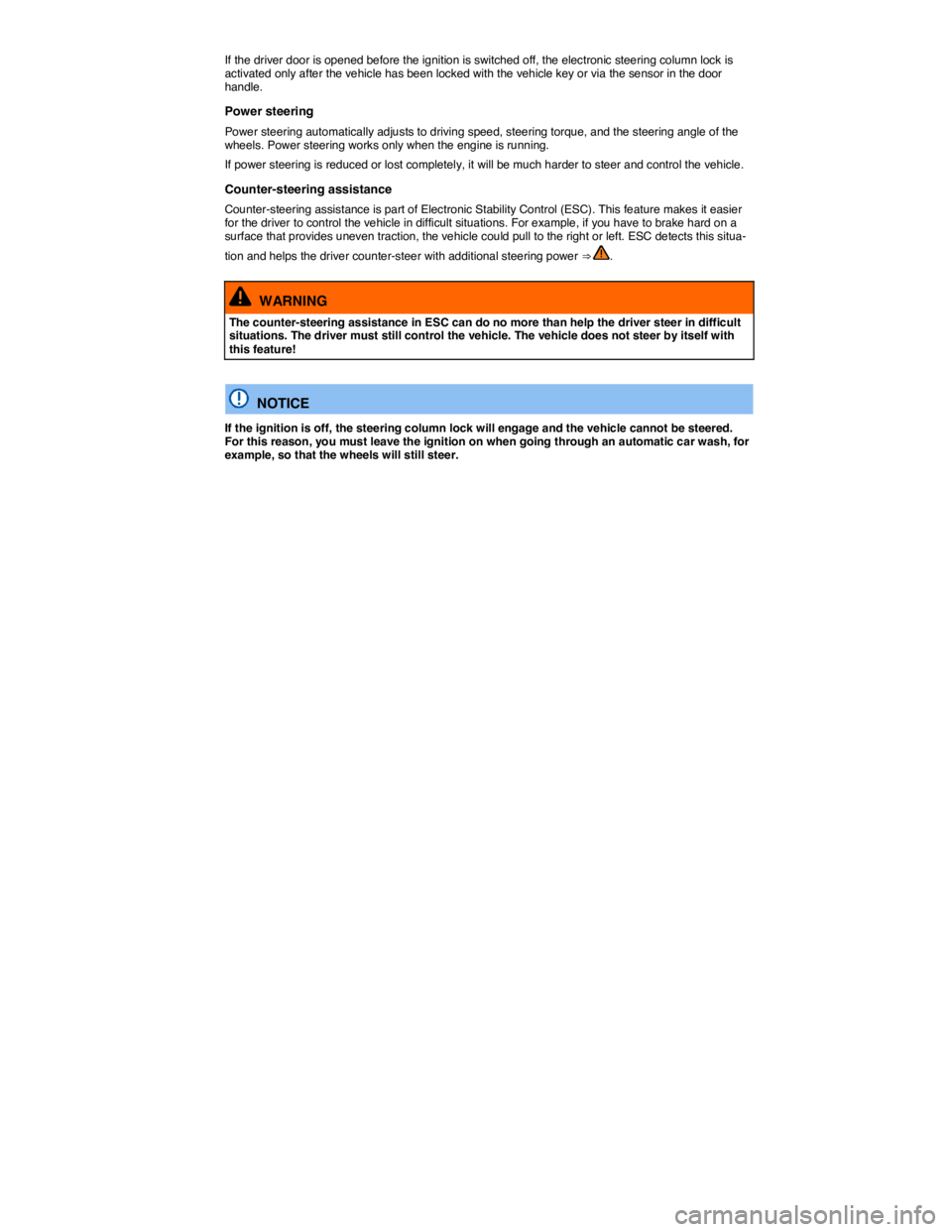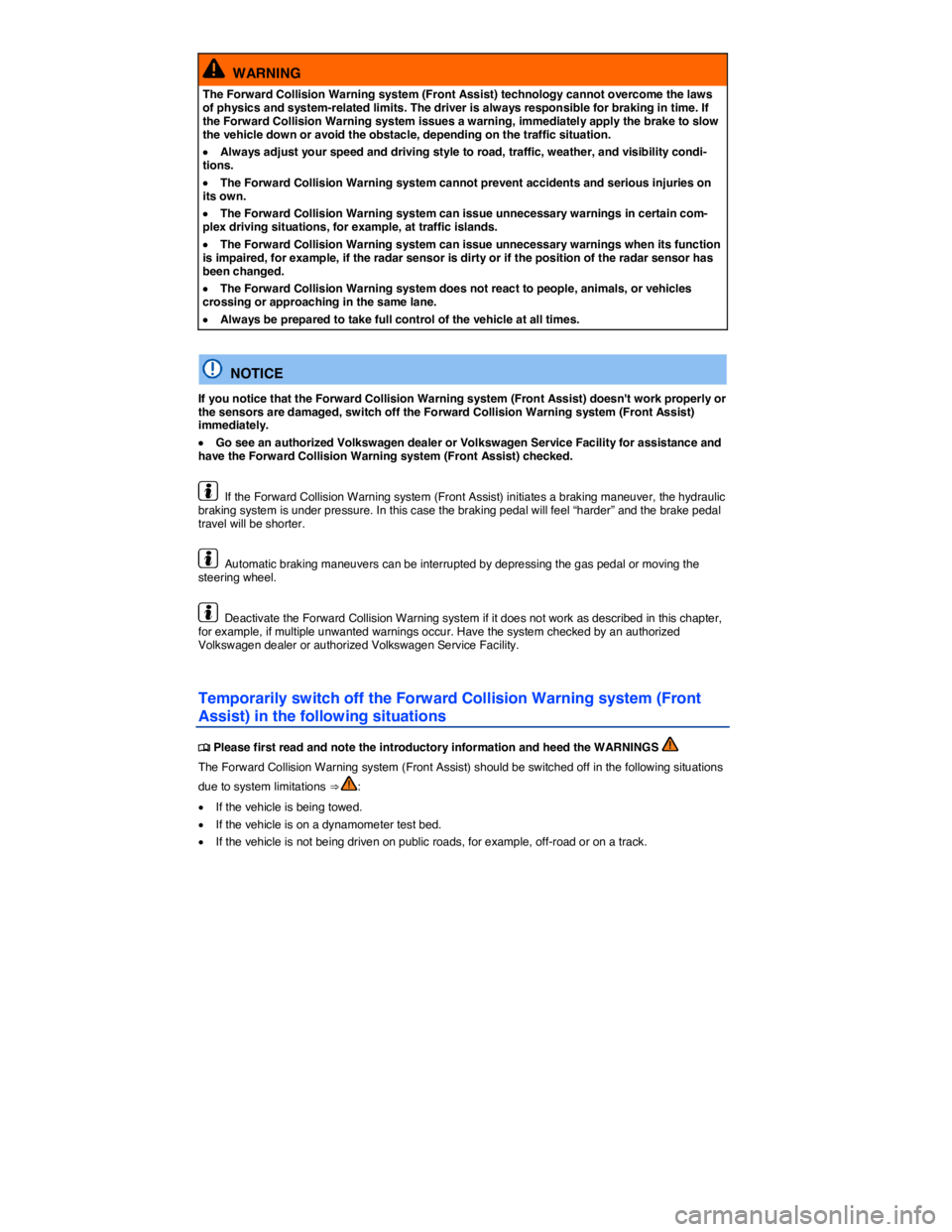2010 VOLKSWAGEN TOUAREG wheel
[x] Cancel search: wheelPage 421 of 684

fast cornering. XDL applies enough brake pressure to this wheel in order to stop the slippage. This improves traction, which helps the vehicle stay on track.
WARNING
Driving fast on icy, slippery, or wet roads can lead to a loss of control and result in serious personal injury for you and your passengers.
�x Always adjust your speed and driving style to road, traffic, weather, and visibility condi-tions. Never let the additional safety that ESC, ABS, BAS, ASR, and EDL can provide tempt you into taking extra risks.
�x Braking assistance systems cannot overcome the laws of physics and always prevent loss of vehicle control. Slippery and wet roads are still dangerous even with ESC and the other systems!
�x Driving too fast on wet roads can cause the wheels to lose contact with the road and “hy-droplane.” A vehicle that has lost road contact cannot be braked, steered, or controlled.
�x These systems cannot reduce the risk of accident, for example if you drive too fast for conditions or if you do not keep your distance from the vehicle in front of you.
�x Although these systems are very effective and can help you control the vehicle in many difficult situations, always remember that your vehicle handling control is limited by tire trac-tion.
�x When accelerating on a slippery surface, for example on ice and snow, depress the accel-erator carefully. Even with these systems, the wheels may start to spin, leading to a loss of vehicle control.
WARNING
The effectiveness of ESC can be significantly reduced if other components and systems that affect vehicle dynamics, including but not limited to brakes, tires, and other systems men-tioned above, are not properly maintained or functioning.
�x Always remember that vehicle alterations or modifications can affect the functioning of the ABS, BAS, ASR, EDL, and ESC systems.
�x Changing the vehicle suspension or using an unapproved tire / wheel combination can change the way the ABS, BAS, ASR, EDL, ASR, and ESC systems work and reduce their ef-fectiveness.
�x The effectiveness of ESC is also determined by the tires fitted ⇒ page 175, Tires and wheels.
All 4 wheels must be equipped with identical tires in order for ESC and ASR to work properly. Differences in the tread circumference of the tires can cause the system to reduce the engine power when it is not expected.
If ABS is not working, ESC, ASR, and EDL will also not work.
You may hear noises when these systems are active.
Page 432 of 684

If the driver door is opened before the ignition is switched off, the electronic steering column lock is activated only after the vehicle has been locked with the vehicle key or via the sensor in the door handle.
Power steering
Power steering automatically adjusts to driving speed, steering torque, and the steering angle of the wheels. Power steering works only when the engine is running.
If power steering is reduced or lost completely, it will be much harder to steer and control the vehicle.
Counter-steering assistance
Counter-steering assistance is part of Electronic Stability Control (ESC). This feature makes it easier for the driver to control the vehicle in difficult situations. For example, if you have to brake hard on a surface that provides uneven traction, the vehicle could pull to the right or left. ESC detects this situa-
tion and helps the driver counter-steer with additional steering power ⇒ .
WARNING
The counter-steering assistance in ESC can do no more than help the driver steer in difficult situations. The driver must still control the vehicle. The vehicle does not steer by itself with this feature!
NOTICE
If the ignition is off, the steering column lock will engage and the vehicle cannot be steered. For this reason, you must leave the ignition on when going through an automatic car wash, for example, so that the wheels will still steer.
Page 440 of 684

Driving situa-
tions
Requirements and
conditions Vehicle behavior
– Avoid speeds of over
about 160 km/h
(99 mph).
Efficient sailing is possible with
a speed of about 160 km/h
(99 mph).
– Careful selection of
gear (S).
Sporty driving style with acti-
vated sport program increases
fuel consumption. Efficient
sailing in sport program with
combustion engine automati-
cally switched off is possible
with a speed of about 70 km/h
(43 mph).
Driving in cold
months.
– Do not warm up the
combustion engine by
running it with the vehi-
cle stationary.
The temperature of the com-
bustion engine increases very
slowly, but fuel consumption
increases considerably.
– Careful use of heating
for the rear window,
outside mirror, steering
wheel and front seats.
This prevents energy from
being lost and saves energy
for the electric motor.
– Leave the vehicle in a
garage overnight.
This prevents the high-voltage
battery and the vehicle interior
from cooling down too much.
The optimal temperature of the
high-voltage battery is reached
quicker at the beginning of the
journey and the combustion
engine can be switched off
quicker when the vehicle inte-
rior is sufficiently heated.
Page 443 of 684

This depends on vehicle conditions of the hybrid drive system is normal and is designed to save fuel. The power steering and the braking assistance systems remain active. In certain situations it may be necessary for the system to start the combustion engine even when the vehicle is not moving. With prolonged driving in traffic jams, the combustion engine will be switched on and off to charge the high-voltage battery for the following start-stop phase.
Sailing
If the accelerator is not depressed and the lever is in Drive (D), the internal combustion engine is switched off even at higher speeds. The vehicle then decelerates slower than conventional vehicles.
This feature can be used to help reduce fuel consumption when you keep traffic conditions in mind and can anticipate the vehicles power requirements. Even in this case, the rev counter in the instru-ment cluster displays zero engine speed (0 engine revolutions). The instrument cluster powermeter shows zero.
Brake energy regeneration (Recuperation/charge)
When the vehicle brakes, the electrical energy is generated by the electric motor, which works as an alternator and charges the high-voltage battery. The same thing occurs while the vehicle is coasting to a stop or driving downhill.
Energy regeneration is shown in the instrument cluster display or on the Infotainment System screen. The combustion engine may be switched off automatically in this situation. The instrument cluster powermeter registers below zero.
When the high voltage battery is fully charged, there is no brake energy recuperation, and therefore no engine braking. Recuperation and engine braking are also automatically reduced if the vehicle detects that the road conditions do not permit sufficient contact between the wheels and the road surface.
Automatic starting - combustion engine
The combustion engine is started automatically in a number of situations.
�x Engine temperature is too low.
�x Catalytic converter temperature is too low.
�x High-voltage battery being charged at high rate when decelerating. The high-voltage battery can-not absorb any more energy and for this reason the electric motor cannot brake the vehicle. The combustion engine comes on to help slow the vehicle down (engine brake).
�x Engine hood is open.
�x Leaving the vehicle when the electric motor is still “live”. The status of the electric motor is not always obvious, particularly when the combustion engine is not running. The combustion engine will therefore start if the driver's safety belt is unlatched or the driver's door is opened when the transmis-
sion is in Park (P) or Neutral (N) ⇒ Warning when leaving the vehicle.
Page 458 of 684

There are 2 radar sensors next to the fog lights on the vehicle front (3). These can detect moving vehicles up to 590 ft (180 m) in front of your vehicle.
The areas of the sensors (2) and (3) and the camera (1) must not be spray painted on or covered by stickers or other objects, since this can lead to a malfunction of the Adaptive Cruise Control (ACC) and the Front Assist system.
NOTICE
If you notice that Adaptive Cruise Control (ACC) or Front Assist doesn't work properly or the sensors are damaged, switch off ACC immediately.
�x Go see an authorized Volkswagen dealer or Volkswagen Service Facility for assistance and have the ACC system checked.
�x The sensors can be damaged or become misaligned in low speed impacts and parking maneuvers. Damaged or misaligned sensors can cause ACC or Front Assist to malfunction.
�x To help make sure that the system works properly, always keep the sensors clean, free of snow and ice; do not cover the sensors with stickers or other objects.
�x When cleaning the sensors with power washers or steam cleaners, only spray the sensors directly for a very short time, and always keep the washer nozzle at least 4 inches (10 cm) from the sensors.
�x For Declaration of Compliance to United States FCC and Industry Canada regulations
Always keep the area of the Front Assist camera clear of ice and snow.
Switching ACC on and off
Fig. 272 On the steering wheel column: Lever for Adaptive Cruise Control.
Fig. 273 Lever for Adaptive Cruise Control: Setting the distance (time intervals)
Page 468 of 684

WARNING
The Forward Collision Warning system (Front Assist) technology cannot overcome the laws of physics and system-related limits. The driver is always responsible for braking in time. If the Forward Collision Warning system issues a warning, immediately apply the brake to slow the vehicle down or avoid the obstacle, depending on the traffic situation.
�x Always adjust your speed and driving style to road, traffic, weather, and visibility condi-tions.
�x The Forward Collision Warning system cannot prevent accidents and serious injuries on its own.
�x The Forward Collision Warning system can issue unnecessary warnings in certain com-plex driving situations, for example, at traffic islands.
�x The Forward Collision Warning system can issue unnecessary warnings when its function is impaired, for example, if the radar sensor is dirty or if the position of the radar sensor has been changed.
�x The Forward Collision Warning system does not react to people, animals, or vehicles crossing or approaching in the same lane.
�x Always be prepared to take full control of the vehicle at all times.
NOTICE
If you notice that the Forward Collision Warning system (Front Assist) doesn't work properly or the sensors are damaged, switch off the Forward Collision Warning system (Front Assist) immediately.
�x Go see an authorized Volkswagen dealer or Volkswagen Service Facility for assistance and have the Forward Collision Warning system (Front Assist) checked.
If the Forward Collision Warning system (Front Assist) initiates a braking maneuver, the hydraulic braking system is under pressure. In this case the braking pedal will feel “harder” and the brake pedal travel will be shorter.
Automatic braking maneuvers can be interrupted by depressing the gas pedal or moving the steering wheel.
Deactivate the Forward Collision Warning system if it does not work as described in this chapter, for example, if multiple unwanted warnings occur. Have the system checked by an authorized Volkswagen dealer or authorized Volkswagen Service Facility.
Temporarily switch off the Forward Collision Warning system (Front
Assist) in the following situations
�
Page 471 of 684

The Autonomous Emergency Braking function should be deactivated by switching off the Forward Collision Warning system (Front Assist) in following situations:
�x When the vehicle is being towed.
�x When the vehicle is on a roller test stand.
�x When the vehicle is off road, like on construction sites or on race tracks.
�x When one of the sensors is defect.
�x When the sensors have been damaged, like after a frontal collision accident.
�x After several false alarms in a row.
�x If the sensors are covered by additional parts, like auxiliary headlights.
�x If the vehicle is driving on steep terrain or on or across slopes.
WARNING
Always remember that the Autonomous Emergency Braking function has limits – it will not release you from the responsibility to control and slow down your vehicle.
�x The Autonomous Emergency Braking function alone cannot avoid accidents and fatal injuries.
�x Under certain circumstances and complex traffic situations the Autonomous Emergency Braking function can perform unwanted braking maneuvers, like in construction sites.
�x Soiled or misaligned radar sensors can lead to unwanted braking maneuvers
�x The Autonomous Emergency Braking function does not react to people, animals, crossing traffic or vehicles that are approaching you on the same lane.
�x Always adjust your speed and the distance you keep between you and the vehicles ahead of you to the road, traffic, weather, and visibility conditions.
�x Never follow a vehicle so closely that you cannot stop your vehicle safely, under certain circumstances the automatic braking function cannot bring the vehicle to a stop in time.
�x Never allow the closing speed between you and other vehicles to be so high that the Au-tonomous Emergency Braking function may not be able to slow your vehicle safely. If closing speed is too high, you must apply the brakes yourself to reduce the risk of a rear-end crash.
�x Always be prepared to takeover the control of the brake and the gas pedal in every situa-tion.
NOTICE
If you notice that the Autonomous Emergency Braking function doesn't work properly or the sensors are damaged, switch off the Forward Collision Warning system (Front Assist) and therefore the Autonomous Emergency Braking function immediately.
�x Go see an authorized Volkswagen dealer or Volkswagen Service Facility for assistance and have the system checked.
If the Autonomous Emergency Braking function initiates a braking maneuver, the hydraulic brak-ing system is under pressure. In this case the braking pedal will feel “harder” and the brake pedal travel will be shorter.
Automatic braking maneuvers can be interrupted by depressing the gas pedal or moving the steering wheel.
The Autonomous Emergency Braking function can slow your vehicle down to a standstill, but not hold your vehicle permanently. When necessary, apply the vehicle brakes!
Page 480 of 684

Lane Assist settings in the infotainment system
You can change some Lane Assist settings in the infotainment system
�x Switch on the ignition.
�x Push the infotainment button CAR.
�x Tap on the Assistants button in the display.
�x Select Front LaneAssist.
Function key
Warning time setting : After touching the Warning time setting or �z func-
tion key, you can choose between early, medium and late.
Steering wheel vibration : After touching the Steering wheel vibration or �z
function key, you can choose between low, medium and strong.
Setting the warning time
Menu option Meaning
Early The system has a low tolerance level and warns
you early if you come too close to a side marking.
Medium Original setting.
Late The system has a high tolerance level and warns
you late if you come too close to a side marking.
The warning time setting defines the distance from your vehicle to the side markings. An early warning time means that the distance to the side markings has to be high in order for Lane Assist not to trigger a warning.
The time of the warning is also dependent on the approach angle to the side marking and the driving speed. If, for example, you approach a road marking at a steeper angle, the steering wheel will start vibrating at a greater distance.
Setting the vibration level of the steering wheel
Menu option Meaning
Low Light vibration of the steering wheel.